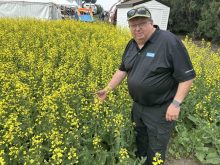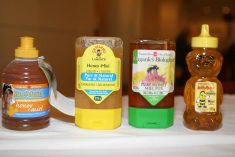SASKATOON – A federal agency has hacked away at acceptable uses for Furadan, but has kept the pesticide alive.
However, Furadan may face complete execution in two years, when the manufacturer, FMC Corporation, must provide scientific data proving the pesticide, mainly used to control grasshoppers and flea beetles, is not a danger to wildlife.
If it fails to prove it is not damaging endangered species such as burrowing owls, Furadan will be completely banned.
While carbofuran-based Furadan’s use on wheat and on roadsides for grasshopper control has been banned, farmers can use it for flea beetle control in canola and mustard.
Read Also

First annual Ag in Motion Junior Cattle Show kicks off with a bang
Ag in Motion 2025 had its first annual junior cattle show on July 15. The show hosted more than 20…
Tony Zatylny, crop production co-ordinator for the Canola Council of Canada, said canola producers are relieved one form of granular Furadan is still legal, but he said they are worried about what will happen at the end of 1997, when the Pest Management Regulatory Agency reviews the scientific data.
Furadan is one of only two pesticides that can be used to control flea beetles. The regulatory agency has banned the CR-10 application of Furadan, a granular form with 10 percent carbofuran, but is allowing the five percent 5G use to continue, with some restrictions, for at least two years.
Producers using 5G Furadan cannot use double disk press drills or any other type of discer seeder and cannot broadcast the pesticide under the new restrictions. Those who ignore the regulations can be prosecuted under pesticide laws, according to regulatory agency registration head Wayne Ormrod.
Pesticide dealers and producers can use old stocks of CR-10 until the end of 1997.
Saskatchewan Wheat Pool director and canola grower David Sefton said, “I’m not sure if it’s a partial victory or a partial loss.”
He said allowing some use in canola is good but the restrictions on seeders might be irksome for some. As well, he called for further research.
But Ormrod said air seeders, the seeding method that poses the least danger to birds, are becoming more prevalent, so seeding regulations should not be too onerous.
Julia Langer of the World Wildlife Fund, a group that argued for a total Furadan ban, cheered the new restrictions.
She said the WWF hopes farmers do more than just cut back on their Furadan use and move away from heavy pesticide use overall.
“What this really does is signal the need to expand the alternatives.”
Prove the claim
She called the new restrictions a victory for the burrowing owl, especially the requirement that the chemical manufacturer prove it is not a danger to birds.
Migrating birds often land in fields during seeding and can mistake Furadan granules for food. The CR-10 granule contains six times the lethal dose of carbofuran for a small bird, so one swallow could be deadly.
While the 5G granules contain about three times the lethal dose, no proof has been found that shows birds have died from eating it.
Langer said she thinks 5G should have been banned too because having three times the lethal dose of carbofuran makes it deadly to endangered birds.
Ormrod said the regulatory agency looks at the practical risks, as well as the theoretical hazards a product presents. If no birds appear to have died from 5G, there is little reason to ban it.
A commonly used chemical is usually difficult to ban, according to Langer. Often, it’s up to a group such as the WWF to scientifically prove it is dangerous.
But the Pest Management Regulatory Agency’s demand that the manufacturer prove Furadan is benign marks the first time in many years the onus of proof has been reversed, said Langer.

















